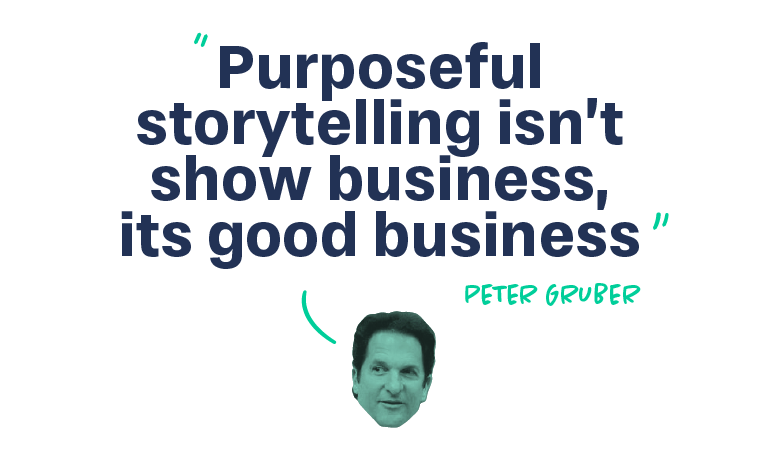Storytelling – the secret weapon to any succesful presentation
How storytelling can transform your presentation from a mere information dump into a memorable and impactful experience.

The best presentations are those that not only inform, but also inspire, move, and leave a lasting impression. More than just conveying information, storytelling builds bridges of human connection, persuasion, and understanding. From our earliest days, stories have been the way we share our world, evolving from spoken tales to the rich tapestry of books, plays, and films.
Research reveals that storytelling is a vital tool for inspiring interest and support for new ideas. When we connect with a story, we engage emotionally, leading to deeper understanding and participation. Storytelling’s power lie s in its ability to create empathy and relatability, quickly forging connections and overcoming communication barriers, especially when you’re reaching out to a new audience.

Death by PowerPoint
It is a fairly uncontroversial claim that inspiring and truly engaging presentations are in scarcity in the corporate world. In corporate meeting rooms, fully remote summits, seminars, and the like. “Death by PowerPoint” is really a thing.

The term describes the experience of enduring a tedious and ineffective presentation, typically one that heavily relies on PowerPoint slides. It’s characterised by:
- Overly text-heavy slides
Slides packed with dense paragraphs of text, often read verbatim by the presenter. - Lack of engagement
Presentations that fail to capture or maintain audience attention, leading to boredom and disinterest. - Poor visual design
Slides with cluttered layouts, distracting animations, or irrelevant graphics.
- Presenter dependence on slides
The presenter relies too heavily on the slides, rather than engaging with the audience and providing meaningful explanations. - Monotonous delivery
A dull and uninspiring presentation style that further contributes to audience disengagement.
Essentially, “death by PowerPoint” occurs when the presentation tool becomes a crutch, hindering effective communication rather than enhancing it. It results in a passive and unmemorable experience for the audience.
Storytelling to the rescue
Storytelling is a potent force, bridging the gap between informing, connecting, and persuading. It’s an ancient art, the cornerstone of human connection, predating written language and evolving through spoken word, books, plays, and film. Research confirms its power: stories captivate, fostering engagement and driving support for innovative ideas in any setting. When audiences are drawn into a narrative, they listen, question, and participate, leading to more impactful outcomes. Furthermore, storytelling builds rapport through empathy and shared experience, quickly dismantling communication barriers and forging connections, even in unfamiliar settings.
Why storytelling works
Storytelling is a powerful tool that can significantly enhance a presentation. Here’s how it benefits your audience and your overall message:
- Enhanced Engagement
Stories capture attention and hold it. They create a sense of anticipation and make the audience want to know what happens next. - Improved Memory and Retention:
People are more likely to remember stories than they are to remember isolated data points.
Stories provide context and emotional connection, which helps information stick. - Emotional Connection:
Stories evoke emotions, which can create a deeper connection between the speaker and the audience. This emotional connection can make the message more persuasive and impactful. - Increased Understanding:
Stories can simplify complex concepts and make them easier to understand.
By framing information within a narrative, you can provide context and make it more relatable. - Persuasion and Influence:
Stories can be used to illustrate the benefits of a product, service, or idea.
By showing how something has helped others, you can persuade the audience to take action.

But, what is storytelling in a presentation then?
We probably all have a clear idea what storytelling is in movies, music, adversing and other fields of the entertainment industry. But what is storytelling in a presentation?
In a presentation storytelling can be incorporated in numerous ways. It should be considered in everything you do. The visuals you include, the structure of your presentation, the delivery of your message, your body language, or the design of your slides.
You don’t have to do everything at once, obviously. But having awareness of how presentations gives a wide vocabulary of how storytelling can be included is key. So try to consider carefully how each element of your presentation contributes to the narrative.
Storytelling involves using narrative techniques to convey information in a compelling and memorable way. It goes beyond simply presenting facts and figures; it aims to engage the audience on an emotional and intellectual level.
Introduce a problem or challenge that creates tension and keeps the audience engaged. Use language and imagery that evokes emotions and creates a memorable experience.

How to incorporate storytelling
Storytelling can transform a mundane presentation into a captivating experience. Here are some examples of how to effectively use storytelling in various presentation scenarios:
In the structure
Think of your presentation as a story. Presenting an idea within a narrative allows your audience to engage with it. Presentations are no exception.
Create a basic skeleton to help you build a dramatic structure. This structure can vary, depending on your content, your audience, and the setting, of course. But simply by following a classic three-part story structure (beginning, middle, and end), you can create a more engaging message that is easier to digest, remember, and retell.
A coherent narrative should be the backbone of a compelling presentation. While each slide can have a clear individual message, the true power lies in weaving them into a single, compelling story. This will guide your audience and connect disparate points, making your message memorable. Without it, your presentation risks becoming a jumble of facts. A strong narrative arc keeps the audience engaged and invested throughout.

In your visuals
In your copy writing
In the narrative
In your delievery
- Customer Success Stories for Sales Presentations:
Scenario: Pitching your company’s services to a potential client.
Story:
Instead of just listing features, tell the story of a previous client who faced a similar challenge.
Describe their initial struggles, the solutions your company provided, and the measurable results they achieved.
Use specific details and quantifiable data to make the story relatable and impactful.
For example, instead of saying “we increased sales”, say “we increased client X’s sales by 30% in 6 months, by implementing these specific strategies”.
- Personal Anecdotes for Inspiring Presentations:
Scenario: Delivering a keynote speech about overcoming adversity.
Story:
Share a personal experience where you faced a significant challenge and how you overcame it.
Focus on the lessons you learned and how they can apply to the audience’s lives.
Authenticity and vulnerability are key to connecting with the audience on an emotional level.
- The “Problem-Solution” Narrative for Data-Driven Presentations:
Scenario: Presenting data on a declining market trend.
Story:
Start by painting a picture of the current situation, highlighting the problem and its consequences.
Introduce your data and analysis as the evidence that supports your narrative.
Present your proposed solutions as the “turning point” in the story, demonstrating how they can reverse the trend and lead to positive outcomes.
This structure helps to make data more engaging and easier to understand.
Key Elements of Effective Storytelling:
Relatable Characters: Create characters that the audience can connect with, whether they are real people or hypothetical scenarios.
Compelling Conflict: Introduce a problem or challenge that creates tension and keeps the audience engaged.
Clear Resolution: Provide a satisfying conclusion that demonstrates the value of your message.
Emotional Connection: Use language and imagery that evokes emotions and creates a memorable experience.
By incorporating these storytelling techniques, you can transform your presentations from informative to impactful.
Build a dramatic structure
Inject emotion
Whether it’s making them laugh or pulling on their heartstrings, an emotional response keeps your audience hooked. The key is to tell a good story using your visuals, personal anecdotes, body language, or any other storytelling techniques that incorporate emotion. Remember, your goal is to create a connection with your audience that they will remember long after the presentation has ended.

Tell one coherent story

These are a few of what we consider the most crucial and fundamental storytelling techniques we use in almost any presentation project. However, there are countless ways to incorporate and work with storytelling in a presentation. It’s of course important to highlight that it’s not a fixed set of techniques you need to incorporate every time. Storytelling is more like a fundament that should always be present in any presentation.
We believe stories in a corporate setting are the glue that humanizes business meetings, making them more engaging, effective, compelling, memorable, and successful.




